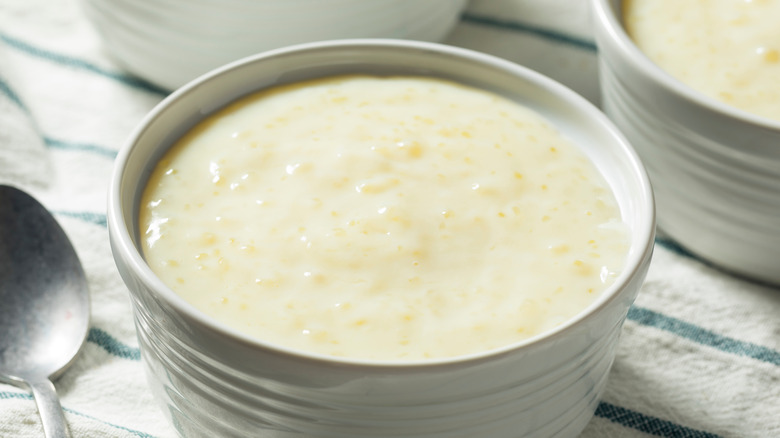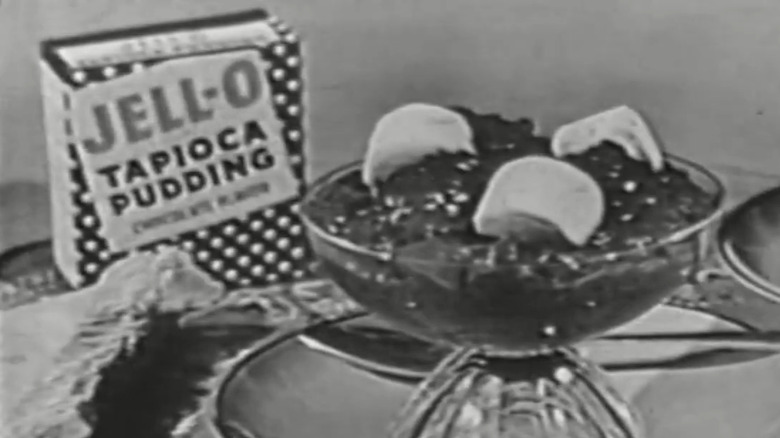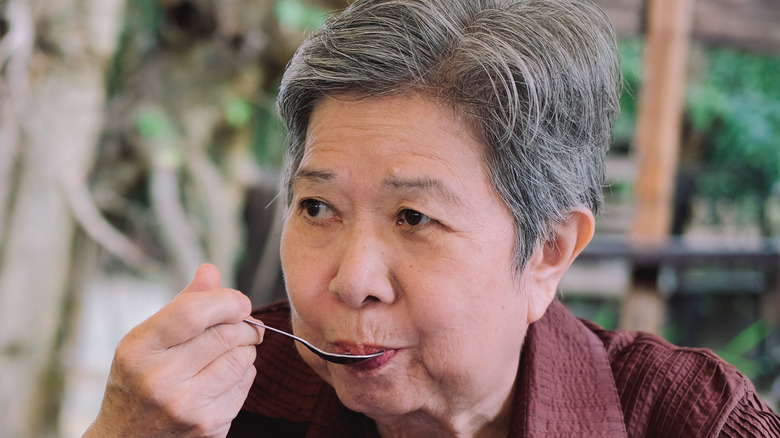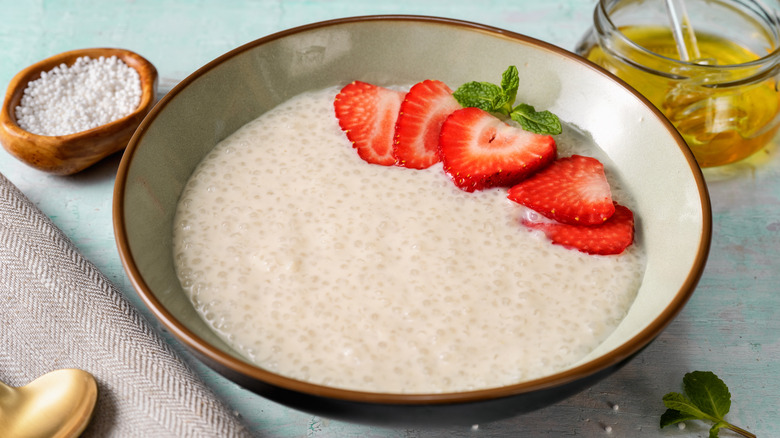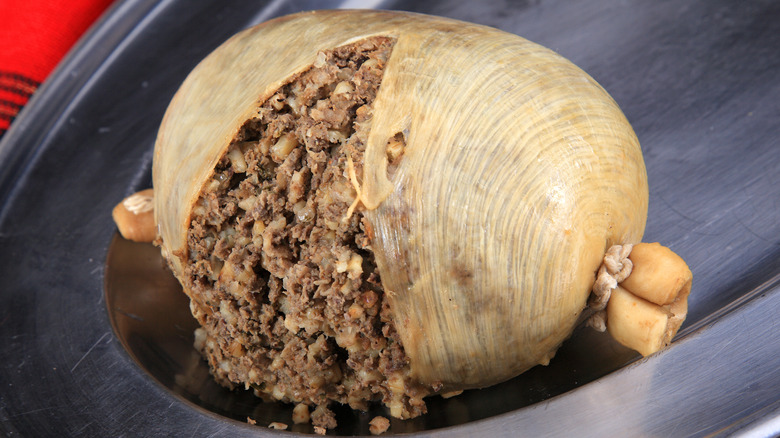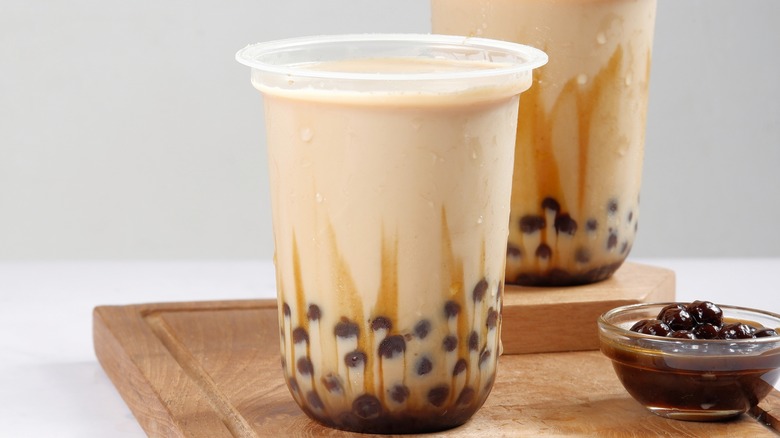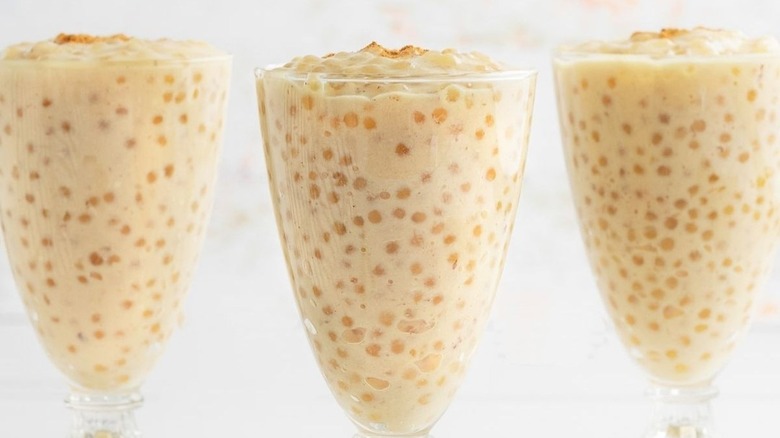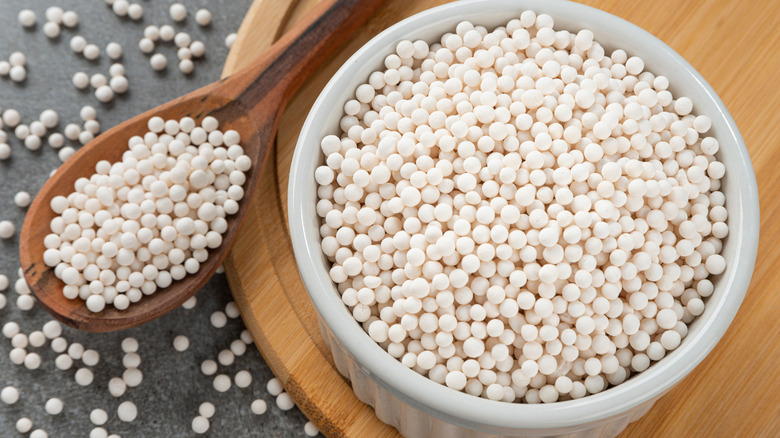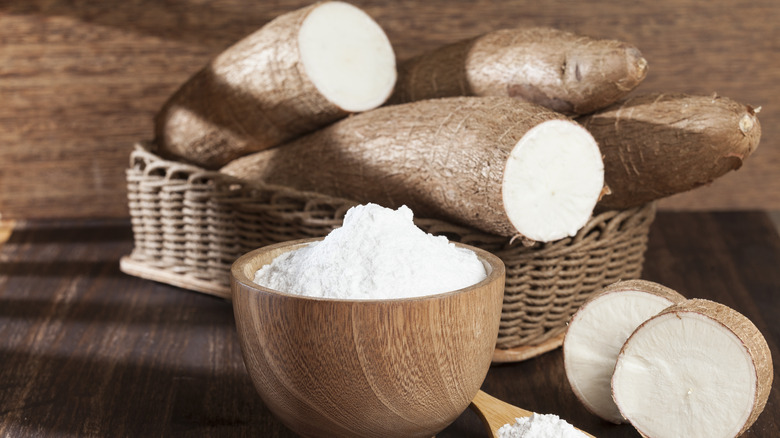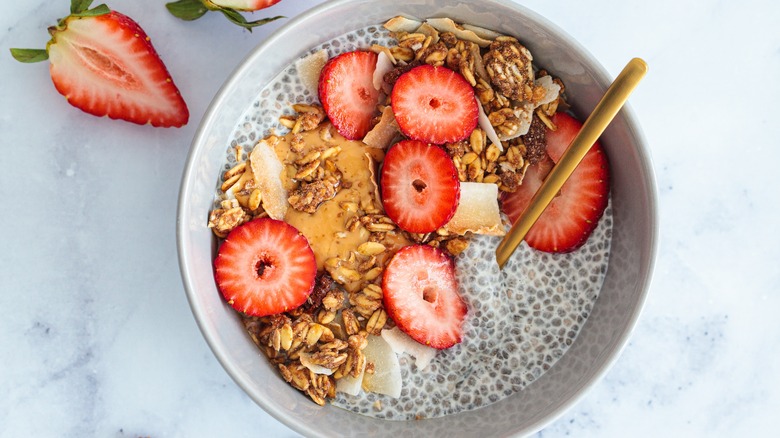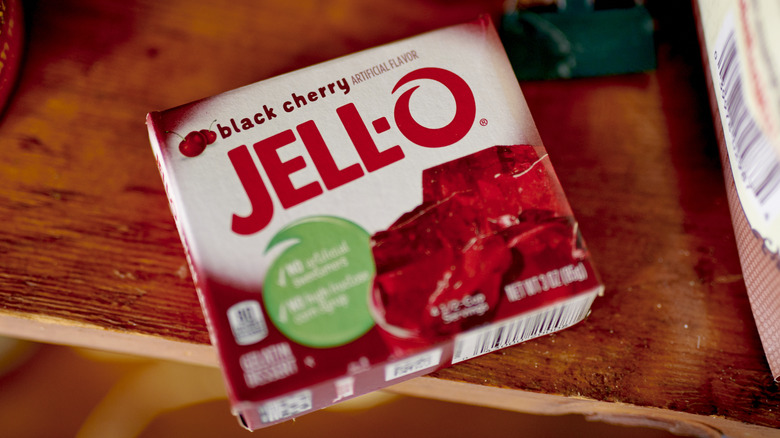Why Tapioca Pudding Fell Out Of Popularity
Tapioca pudding is a dessert with a mournful history. In a span of 100 years, this creamy and delicate dessert has gone from a rare delight to a kitchen staple to an obscure indulgence. While it's a fairly common trajectory for people to eventually stop eating popular foods, the story of tapioca pudding is a particularly salient example of this phenomenon. After all, few other foods have gone from a staple of the American kitchen to an object of disgust quite as fast as tapioca.
In spite of this, it is hard to pin the downfall of tapioca pudding on any one factor. Its shift towards obsolescence was the culmination of several external forces, each compounding atop the other until tapioca pudding disappeared from restaurant menus. Fortunately for the few remaining devotees of tapioca pudding, the dish isn't fully defunct. You can still find tapioca mix and premade tapioca pudding on the shelves in many different grocery stores. However, if you love this classic American dessert, you should enjoy it while you still can. The dish is on a course towards total irrelevance. Let's explore exactly how this came to be.
It has been around for a long time
Of all of the reasons tapioca pudding has fallen out of relevance, the passage of time is the biggest factor. Simply put, tapioca's moment in the spotlight came and went, and when the hype was over, most consumers moved on in search of something new. Thankfully, the dish had a good long run.
While variants of tapioca pudding have been around for much longer, the version that we know best was popularized in the late 19th century. It was then that Boston housewife Susan Stavers first concocted the recipe that would become Minute Tapioca. This brand advertised aggressively from the beginning all the way past the post-war period, ensuring that its product remained a household name for several decades. But as the dish lost its appeal as a hot new commodity, Minute Tapioca's momentum eventually came to a halt.
By this time, the company had been bought out by General Foods, and under the influence of market conditions, the conglomerate shifted its marketing focus to its other brands. Before long, tapioca pudding began to appear on fewer restaurant menus, and take up less space on grocery store shelves.
Consequently, it is now considered old people food
Because of how long ago tapioca pudding fell out of relevance, there is a clear age gap between those who have a fond nostalgia for the flavor and those who don't. Today, this gives tapioca pudding the unfortunate stigma of being "old people food." One user on X, formerly known as Twitter, wrote, "Tapioca is for old people, I am young and beautiful." Another X user wrote, "Tapioca is just boba for old people." The sentiment has so much reach that it has become a part of pop culture.
The idea was most notably reinforced around 2003 by the children's TV show "Codename: Kids Next Door." Season 2, Episode 16 of the show is titled Operation: T.A.P.I.O.C.A., and follows the protagonists in their efforts to stop a crew of senior citizen supervillains from stealing a tanker truck full of tapioca pudding. This episode shaped the opinions of many millennial viewers, as indicated by this tweet, which further helps to explain why so many people consider tapioca to be old people's food.
It was ruined by low-quality school meals
While many G.I. and Silent Generation members are fond of tapioca pudding, others have negative memories of the treat — particularly those from across the pond. When 2,000 users of the U.K. Friends Reunited website and BBC Good Food magazine were surveyed about their least favorite school meals, tapioca pudding surprisingly topped the list. It even beat out other commonly disliked foods such as liver, cabbage, and overcooked vegetables.
And these old wounds aren't healed either. More than half of those questioned said the experience of school dinners still affected their eating habits today (via the Guardian). Survey participants weren't asked to explain why it was their least favorite, but there is a good chance that it has to do with the generally low quality of cafeteria meals. After all, school dinners are almost as notoriously disliked as airline food. Don't worry, though, it could be worse. Jell-O has the unfortunate distinction of being served in both prisons and hospitals.
Pudding has always had a bad reputation
Depending on what part of the world you're from, the term pudding can mean a number of different things. And that's not the best news for whoever is in charge of tapioca pudding's PR. While Americans usually use the word pudding to refer to sweet, milk-based dessert with a custard-like texture, the British definition of pudding refers to a larger and more complex category of foods. And British pudding does not have a particularly appetizing history.
The British term pudding basically refers to anything that's been boiled or steamed within a container. Under this definition, the term also applies to the earliest versions of this dish, which were less like custard and more like haggis. As we've covered before, pudding originally incorporated a mèlange of ingredients like minced meat, spices, cereal, and blood stuffed into an animal casing. Although this has been the case since before tapioca pudding was even popularized, it still probably detracted from pudding's popularity in a way worth mentioning.
Bubble tea took over as the new tapioca trend
As previously mentioned, people are always looking for new flavors to expand their culinary horizons and bring modern excitement to their meals. The fact that one of the world's biggest and latest crazes, bubble tea, is a different tapioca-based dessert does not bode well for the future of tapioca pudding. What exactly is bubble tea, though? It is a sweet Taiwanese beverage that was invented in the 1980s. It combines tea, milk, and tapioca balls to create a rich beverage with a fun, chewy texture. The trendy dessert has quickly become a worldwide phenomenon. Consequently, the bubble tea industry has been growing rapidly year after year, while tapioca pudding sales have dwindled.
Bubble tea is far from finished growing, too. One source projects that the already thriving bubble tea industry will grow from a market value of $2.46 billion in 2023 to $4.08 billion by 2030 (via Fortune Business Insights). With mass popularity like that, there may not be room for yesterday's favorite tapioca dish in the hearts of tomorrow's epicureans.
Its appearance and texture are off-putting to many
While tapioca pudding's unique texture was a point of intrigue when the dish first rose to relevance, it has been around long enough for people to take a hard stance for or against it. And it would seem that many people have decided against tapioca's unusual mouthfeel. The creamy pudding base combined with chewy tapioca pearls provides a type of contrast that you don't often experience in other dishes, making it a textural outlier. Weirder yet, when you bite into a tapioca pearl, you sometimes experience a gentle popping sensation, adding a whole new layer to the experience. Again, some love it, but many don't.
This stigma also persists for the visual appearance of the dish, which has earned it some unfortunate nicknames throughout the years. Members of the same G.I. and Silent Generation that were forced to consume tapioca pudding ad nauseam in boarding school have coined several vile terms for the dessert, including fish eyes, frog spawn, and eyeball pudding. These names obviously all stem from the gelatinous orbs suspended in the pudding. In fairness, you can certainly see the resemblance.
A recent tapioca shortage got people used to life without it
Although tapioca was far from the only export affected by recent supply chain issues, this commodity was hit particularly hard by a recent logistical issue in 2021. During this time, thousands of shipping containers full of tapioca pearls could not enter the American economy for several extra months because of an unexpected bottleneck at California shipping ports. The issue stemmed from a massive backlog of shipping containers in front of this cargo and was compounded by the reopening of the nation after the COVID-19 pandemic.
Naturally, this impacted the availability of tapioca pudding, as manufacturers were left without the key ingredient to this dish. However, the media conversation about this shortage instead revolved around its impact on the growing bubble tea industry, showing just how indifferent people were about the lack of tapioca pudding. Although this shortage ultimately only affected the supply of tapioca for a few months, it was an irreparable blow to the already floundering tapioca pudding industry.
Tapioca production is being jeopardized by climate change
Much like the supply chain issues of 2021, extreme weather conditions caused by climate change are another external force that threatens to limit the world's supply of tapioca. For one example, you can look to Taiwan, a major grower of the world's cassava supply and a huge producer of tapioca pearls. In 2021, Taiwan fell into its worst drought in 56 years, indefinitely decreasing its production capacity of tapioca products (via Modern Farmer). Cassava is a fairly hearty plant, so the squeeze hasn't begun in earnest, but it still bodes poorly for the future of tapioca-based food products.
Cassava is actually well-suited to grow in hot and dry climates, but this type of weather also threatens to accelerate the growth of devastating plant diseases like the cassava mosaic virus and the brown streak virus (via Cornell University CALS). If these drought conditions worsen or spread to other major cassava growers, it could trigger these plant viruses and a more serious shortage. If this does happen, the manufacture of tapioca pudding would likely be the first industry casualty.
Modern consumers are interested in healthier desserts
One recent trend that may hurt tapioca pudding is that shoppers have gravitated toward healthy dessert options in the post-pandemic economy. Today's consumers are more interested in low-sugar options as well as desserts with functional ingredients like probiotics, protein, and fiber. Sadly, tapioca pudding offers none of these benefits. Most of the calories in tapioca pudding come from carbohydrates, which is the equivalent of empty calories from a nutritional standpoint.
Even in the pudding space alone, healthy alternatives are already cutting into tapioca's legacy. Health-conscious dessert enthusiasts might opt for a kefir-based dessert, which delivers both the sweet, creamy texture of pudding and a nice boost of probiotics. Or they might instead opt for chia pudding, which is rich in fiber and omega-3 fatty acids and even has a similar texture to tapioca pudding. With this kind of health-conscious competition crowding the space, it is even more apparent why tapioca pudding is falling into obscurity.
The whole Jell-O brand has seen slipping sales
Another reason tapioca pudding has declined in popularity is because of the dwindling influence of Jell-O, one of the major manufacturers of tapioca pudding. This brand definitely had its moment in the sun, but its sales have dropped steadily despite past and recent efforts to revive it. Jell-O sales started slipping as early as the '70s, but when then-owner General Foods tried to correct the course by switching to pre-packaged single-serve cups and enlisting Bill Cosby as a sponsor, it wasn't enough to pull its failing brand out of its tailspin. The brand was sold to Kraft shortly after, and they had no better luck. In 2012, Kraft CEO Tony Vernon vowed to bring the brand back to relevance, but has instead seen some of the sharpest sales declines in the brand's history since then.
It is curious that both Jell-O and tapioca pudding peaked in popularity around the time of World War II and then subsided afterward, which leaves one to wonder if there was anything General Foods could have done to combat the macro-trends at play. Perhaps if the company had continued to innovate with new flavors and fresh branding, it could have reversed the fate of its products. But the culinary world doesn't have room for ingredients that don't evolve with the times.
